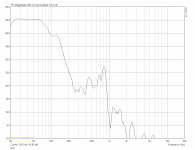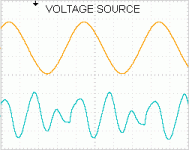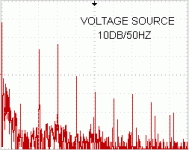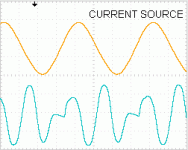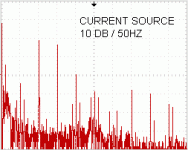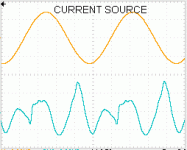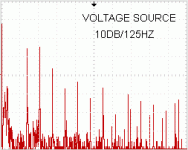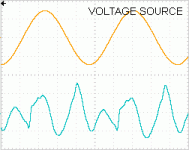Thanks, that is consistent with what I would expect. Do you think that the
SPL level has a contribution from the port?
😎
At this range of frequencies, high probability that yes.
Attachments
Thanks for that, Richard. It looks to be consistent with Pavel's data also.
Still, it looks to me like the motional feedback is positive.
😎
More importantly, either polarity of speaker applied to series fb; try it both ways. Since this discussion has involved I vs E drive --- I think understanding how the distortion is reduced will help settle the I vs V or E or high vs low source Z issue. Don't forget to bring in phase shifts of speaker E/I/Z. 🙂
Let's discuss the reason speaker thd is lowered? Insights gained can be used for better design of amps, perhaps.
The thd can be lowered even more if the speaker, amp and R are optimized together. Now how would that sound?! How many people have heard very low distortion at bass freqs?
I was pretty disappointed, back in 1980's, that others didnt take it and run. I couldnt do it because I had career responsibilities elsewhere. Let's see where you guys can take it.
THx-RNMarsh
Last edited:
Let's discuss the reason speaker thd is lowered?
Good suggestion. Resonance behavior altered?
i(Re) is linearized, with higher Rs or current drive. This applies especially for resonance area.
I have a hard time understanding the physical motions around resonance, it can be seen in a couple of ways, I like this frequency let med aid your motion, or I like this motion so why do you suddenly want the other way, one is demanding less current the other more current to control the cone motion correctly.
The drop in distortion indicates a stronger current drive is needed meaning a higher current than prescribed by the impedance, or a higher voltage over the load where the impedance is peeking. I see one big problem here, maybe you get a better lower distortion sine, but what with the spl level, all is lost if you by lower distortion loose linearity instead. Boomy gets really boomy.
The old cloth trick btw, maybe a better distortion reducer than current drive
The drop in distortion indicates a stronger current drive is needed meaning a higher current than prescribed by the impedance, or a higher voltage over the load where the impedance is peeking. I see one big problem here, maybe you get a better lower distortion sine, but what with the spl level, all is lost if you by lower distortion loose linearity instead. Boomy gets really boomy.
The old cloth trick btw, maybe a better distortion reducer than current drive
Last edited:
I'm sitting here a few feet from the equipment, so I took my desktop Jordan
J92's (nice speakers by the way) in sealed boxes and hooked one up driven
by a voltage source at 1 watt (2.8V) at 50 Hz and snapped the distortion
waveform (about 3%) and its FFT.
Then I put 32 ohms in series with the speaker and set it at the same acoustic
level, and measured it again. I think from the accompanying photos you
will see there is some alteration, but not improvement in the THD.
😎
J92's (nice speakers by the way) in sealed boxes and hooked one up driven
by a voltage source at 1 watt (2.8V) at 50 Hz and snapped the distortion
waveform (about 3%) and its FFT.
Then I put 32 ohms in series with the speaker and set it at the same acoustic
level, and measured it again. I think from the accompanying photos you
will see there is some alteration, but not improvement in the THD.
😎
Attachments
I forgot to mention that, when:
Speaker THD with 10 ohm series resistor at 61Hz (resonance) was 0.381%,
with voltage drive it was 0.593%
voltage was 2.65Vrms in both cases at speaker terminals,
amplifier THD was 0.021% at its output when driving the speaker directly. This is to say that amplifier was not the source of increased speaker distortion when voltage driven.
Nelson, would you please try to find speaker resonance frequency and measure at that frequency.
Speaker THD with 10 ohm series resistor at 61Hz (resonance) was 0.381%,
with voltage drive it was 0.593%
voltage was 2.65Vrms in both cases at speaker terminals,
amplifier THD was 0.021% at its output when driving the speaker directly. This is to say that amplifier was not the source of increased speaker distortion when voltage driven.
Nelson, would you please try to find speaker resonance frequency and measure at that frequency.
Actually, simulations work brilliantly well, I've learnt an enormous amount about the parameters and areas that really matter - where I see the failings in how they are often used is the huge number of assumptions built into a particular model; the classics are "perfect" voltage rails, and ground connections. Once one tosses this nonsense, then the circuit actually behaves far closer to the sort of numbers people do get in real life.Sure no one here really believes the 0,00000 something simulation of LT-spice that flow around here, but to get an idea about the circuit and to see how the currents are, it's really good, in the end of the day you'll have to build an listen
This is the sort of thinking that seems to permeate a lot of the work being done - considering a closed box, that lives in a perfect little world where everything is as one thinks it should be - unfortunately, in the real world the poo does hit the fan, and the concept has to live or die in the bright lights of "reality". I hear so many disasters, from pricey gear where people have blown out their guts sorting out some subtle issue - it's all a bit unfortunate, really ...
Mr Pass, The most interesting part is what happens at the resonance frequency, on your speaker it's likely higher than the 50 Hz. You measure at. I believe the main benefit is where the resonance is, this why I advokate flow damping instead of spring tuning
My suspicion is that they would be rather disappointed - I have a sneeking feeling that people enjoy hearing all those extra harmonics injected by the driver misbehaving - the "Wow, I love that bass you're getting - it's sooo rich and full" type of thing.The thd can be lowered even more if the speaker, amp and R are optimized together. Now how would that sound?! How many people have heard very low distortion at bass freqs?
The fellow member nearby, who has built an extemely solid pair of subwoofers, ran a frequency sweep on the system a few times - very clean, just a couple of tiny twitches higher up. But the bass was rock solid - "Only the fundamentals, ma'am ..." - very unexciting, but "true" sound. Having a DEQX ensured accuracy - and what was the result? For those who get off on "enriched" bass probably pretty disappointing - but to my ears it was very trouble-free and consistent in that area ...
Mr Pass, The most interesting part is what happens at the resonance frequency, on your speaker it's likely higher than the 50 Hz. You measure at. I believe the main benefit is where the resonance is, this why I advokate flow damping instead of spring tuning
That's exactly what I have measured, Michael, decreased distortion at frequency of resonance, with 10 ohm series resistor. SPL (voltage) at speaker same as when voltage driven, i.e. amplifier output voltage proportionally increased when 10 ohm resistor was used.
I should have left the test rig running...
Here are the results of running the tests at resonance, which is 85 Hz.
Because of the higher output 1 watt with the voltage source I had to move
the mic back a bit, and obtained the following with the voltage source and
the 32 ohm source. The THD was around 1.3%
You will see that there is even less difference than at 50 Hz.
I speculate that the distortion reduction you experienced may be related
to the tuned output of your port.
😎
Here are the results of running the tests at resonance, which is 85 Hz.
Because of the higher output 1 watt with the voltage source I had to move
the mic back a bit, and obtained the following with the voltage source and
the 32 ohm source. The THD was around 1.3%
You will see that there is even less difference than at 50 Hz.
I speculate that the distortion reduction you experienced may be related
to the tuned output of your port.
😎
Attachments
About .2% with voltage source, a little more 3rd harmonic with current
source, about .25%.
😎
source, about .25%.
😎
That's exactly what I have measured, Michael, decreased distortion at frequency of resonance, with 10 ohm series resistor. SPL (voltage) at speaker same as when voltage driven, i.e. amplifier output voltage proportionally increased when 10 ohm resistor was used.
To be clear, in my measurements I am reading the same acoustic output
with a microphone.
😎
My suspicion is that they would be rather disappointed - I have a sneeking feeling that people enjoy hearing all those extra harmonics injected by the driver misbehaving - the "Wow, I love that bass you're getting - it's sooo rich and full" type of thing.
The fellow member nearby, who has built an extemely solid pair of subwoofers, ran a frequency sweep on the system a few times - very clean, just a couple of tiny twitches higher up. But the bass was rock solid - "Only the fundamentals, ma'am ..." - very unexciting, but "true" sound. Having a DEQX ensured accuracy - and what was the result? For those who get off on "enriched" bass probably pretty disappointing - but to my ears it was very trouble-free and consistent in that area ...
I don't much care about 'they' and speculation if 'they' like this or that. I am not disappointed by lower distortion.... never.
Like I said.... didnt I say this.... the phase near resonance of the speaker Z is not as a resistor in series with the speaker. It does have affect in series with Rg of my configuration.
Clue:
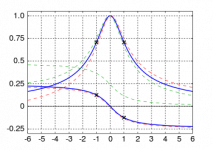
THx-RNMarsh
Last edited:
The kind of resonance must also have an influence. The bass reflex resonance
looks like a parallel circuit since it makes the impedance rise; otoh the mass / spring
resonance of a chassis must look like a series circuit as we are used from a quartz
crystal equivalent network. It would be damped by the radiation resistance and, much more
by the Ohmic resistance of the voice coil which is usually 30% of the nominal impedance.
Series & parallel resonances would behave very differently in case of voltage/current
excitation.
The 30% ohmic part also makes the concept of damping factor just marketing babble
as someone noted a few pages earlier, and fully correctly. With a 0.0001 Ohm amplifier
impedance you can control exactly NOTHING in a chassis that has 2 parasitic Ohms
in series.
I have once made experiments with equalisation after St°al. He uses a negative
amplifier impedance to cancel the parasitic resistance. If you have achieved that,
you can play with virtual mass/springs and enforce ridiculouly low corner frequencies.
It is just moving around large amounts of reactive power.
The efficiency becomes ridiculous also, that's life.
I gave up when I saw that the ohmic resistance is a function of voice coil temperature
and that it matters and that it is a strong function of the previous music.
Hot voice coils come naturally with low efficiency.
(The ° belongs above the a, maybe I have forgotten a h, that was in a previous life.
I assume the guy is from Sweden.)
looks like a parallel circuit since it makes the impedance rise; otoh the mass / spring
resonance of a chassis must look like a series circuit as we are used from a quartz
crystal equivalent network. It would be damped by the radiation resistance and, much more
by the Ohmic resistance of the voice coil which is usually 30% of the nominal impedance.
Series & parallel resonances would behave very differently in case of voltage/current
excitation.
The 30% ohmic part also makes the concept of damping factor just marketing babble
as someone noted a few pages earlier, and fully correctly. With a 0.0001 Ohm amplifier
impedance you can control exactly NOTHING in a chassis that has 2 parasitic Ohms
in series.
I have once made experiments with equalisation after St°al. He uses a negative
amplifier impedance to cancel the parasitic resistance. If you have achieved that,
you can play with virtual mass/springs and enforce ridiculouly low corner frequencies.
It is just moving around large amounts of reactive power.
The efficiency becomes ridiculous also, that's life.
I gave up when I saw that the ohmic resistance is a function of voice coil temperature
and that it matters and that it is a strong function of the previous music.
Hot voice coils come naturally with low efficiency.
(The ° belongs above the a, maybe I have forgotten a h, that was in a previous life.
I assume the guy is from Sweden.)
Last edited:
Neither am I ... and not implying that a particular person here is after such a behaviour. But, I have heard many a very expensive setup with "pumped up" bass, sometimes ridiculously so - hearing a recording with piano on these is quite bizarre. So, some people obviously like it ...I don't much care about 'they' and speculation if 'they' like this or that. I am not disappointed by lower distortion.... never.
THx-RNMarsh
My experiences with systems which have plenty of available, clean bass, which will be there for when the recording requires it, is that they sound very "normal", there is no artificial quality in that area of the spectrum. In general, most systems do a poor job with pipe organ recitals, IME - the balance between the deep bass and the harmonics of the small pipes is just wrong, the sense of the real thing just does not happen ...
- Status
- Not open for further replies.
- Home
- Member Areas
- The Lounge
- John Curl's Blowtorch preamplifier part II
